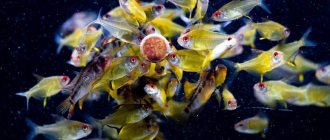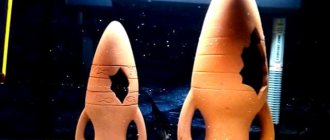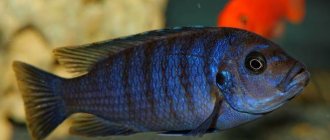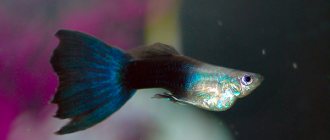Based on the main component of the food taken by certain fish, they are conventionally divided into three groups: herbivores (herbivores), carnivores (predatory) and omnivores. Manufacturers use approximately the same principle to make their food.
Omnivores
They eat everything they can swallow; the daily diet can include both plant components and animal products
Herbivores
Also called herbivores, they feed on algae, aquatic plants, pieces of vegetables, fruits and other vegetation
Carnivores
They feed on insects, their larvae, small crustaceans, worms and other invertebrates. If it is a predator, then other fish
Fish not only prefer different foods, but also consume them in their own way. True predators hunt for prey. “Vegetarians” graze peacefully on leaves, snags or at the bottom, where catfish and other bottom inhabitants collect pieces of food. By region/places of food intake, three groups can be distinguished: those that feed at the surface, throughout the entire volume, or at the bottom, on the lower tier.
Important! Any aquarist needs to know what and where your fish eats in order to choose the appropriate type of food. For example, some catfish will never come to the surface in search of food, and predators will not accept dry flakes or granules.
Carnivores, herbivores or omnivores?
In order to understand how to feed aquarium fish, you need to find out what they eat in their natural habitat. This should be done before setting up the aquarium. You need to choose fish with a similar diet, which will help avoid undereating or overeating.
Fish are conventionally divided into 3 types:
- predators have a capacious stomach, so feeding should be carried out in large portions a small number of times;
- herbivorous species require frequent feeding in small quantities, as they have a long digestive tract designed to digest plant fibers;
- omnivores , adapted to absorb any type of food.
The diet and diet are affected by the size of the fish. If both large and small individuals live in the aquarium, then it will be difficult to organize their nutrition correctly. There is a risk that large individuals will eat small ones.
Feeding the fry
You can grow daphnia yourself without any problems. In addition to feeding purposes, daphnia is also of interest for observation. Especially for fry, it is advisable to have several jars with rotifers. For very small fry, hobbyists “keep ciliates on hand.”
Use yogurt as additional food for the fry. Some hobbyists cultivate enchytraeus at home. It is quite easy to maintain. To enrich the worm with vitamins, it is necessary to add waste vegetables, etc. to its diet. Feeding fish with enchytraeus can cause obesity, therefore, like any other, this type of food must be alternated.
How many times a day should you feed your fish?
The number of meals differs between fry and adults. Juveniles are often fed 3-4 times a day in small portions so that the food is quickly eaten and the water is not contaminated with food debris. Adults are fed 1-2 times a day, not more often.
The amount of food should be such that the fish have time to eat it in five minutes. Residues will immediately spoil the water. This can cause the fish to get sick and die. The exception is catfish, which may not leave their hiding places for the whole day.
Feeding is carried out at the same time, as the fish quickly develop a conditioned reflex.
The best
It is preferable to feed frozen food. The possibility of infecting the aquarium is minimized. Freezing is easy to dose, does not spoil, and retains its taste and beneficial properties. Mixtures of several types of worms are available for sale, making the food more nutritious.
Feeding rules
Proper feeding of aquarium fish is based on three basic rules:
- time to eat no more than 5 minutes;
- avoid overeating;
- Filter systems must be running during feeding.
You can understand that fish are overeating by the following signs:
- cloudiness of water;
- the fish rise to the surface and breathe heavily;
- the smell of mud or fish from the water;
- the appearance of algae on glass;
- bacterial film on the surface and walls of the aquarium;
- slime on aquarium plants.
What happens if you overfeed?
Under natural conditions, a fish must make a lot of effort to fill its stomach. In an artificial reservoir, including an aquarium, abundant food is supplied systematically, and the fish does not have to waste time and effort searching for it.
As a result , the fish, by nature a rather voracious creature , tries to eat all the food, and, as a result, begins to suffer from obesity; this disease immediately entails another one - infertility. The ending may be even more dire: the fish may die because their stomachs cannot digest the large volume of food they eat.
In addition, when overfeeding, food residues fall to the bottom of the aquarium, into the soil, and, decomposing, spoil the water: it becomes cloudy due to the rapid proliferation of microorganisms and turns into an ideal environment for various infections. Also, during the decomposition of microorganisms in water, oxygen is absorbed, and ammonia and nitrates are released, which can poison fish and plants.
What to feed the fish?
All fish food in an aquarium can be divided into four groups - branded, frozen, live food and plant food.
To maintain ideal health, it is better to feed all types of food. Yes, some types of fish eat only live food, others can only eat plant food. But for ordinary fish, the ideal diet consists of branded food, constant live feeding, and occasional plant feeding.
Branded food
Branded food - granules, tablets, flakes
If you buy real food and not a fake, then branded food can become the basis of the diet for your fish. Modern branded fish food contains all the necessary nutrients for health. Buying such food will not cause any problems, because... the choice is huge.
Separately, you should pay attention to dry food - daphnia, dried gammarus and cyclops. This is a very bad option for feeding any fish, because... does not contain essential nutrients, is poorly digestible and serves as an allergen for people.
Also, do not use dry food - dried daphnia. It contains very few nutrients; fish suffer from gastrointestinal diseases and grow poorly.
Live food
Bloodworm for fish
One of the best food for fish. Live food should be regularly fed to the inhabitants of the aquarium, but do not feed the same thing, constantly alternate.
For nutrition, 3 types of live food are most often used:
- bloodworm;
- tubifex;
- coretra.
Live food is highly nutritious, but it is very difficult to ensure the safety of fish when feeding live food. There is always a threat of introducing various types of bacteria into the aquarium. Therefore, the easiest way to keep your fish safe is to freeze the food, thereby killing some of the nasties in it.
Frozen food
Frozen bloodworm
I choose frozen food to feed my fish. Why? Because it is easier to understand the dosage, they are stored for a long time and contain the same substances as live ones. Mixes of coretra, bloodworms and brine shrimp are also sold, which is very convenient.
Plant food
Plant foods are not suitable for all types of fish. For example, predators do not eat plants at all. To understand what to feed a particular fish, read what type of food it prefers. Plant foods are sold both branded and in tablets or flakes.
Types of fish
Existing fish can be divided into three types based on their diet: omnivores, herbivores (herbivores) and carnivores (carnivores).
The diet of omnivorous fish consists of both plant and animal foods.
Herbivorous fish , for example, labidochromis, ancistrus and others, feed on algae, duckweed, pieces of cucumbers, zucchini, apples, pumpkins, and lettuce. Vegetables should be doused with boiling water before feeding them to the fish. In general, the diet of this group of fish should include 70% plant foods and 30% protein. Freeze-dried food with plant ingredients will be an excellent food. Live or frozen food is used as protein food: brine shrimp, bloodworms, and coretra.
Carnivorous or predatory fish eat small crustaceans, insects and their larvae, worms, small fish, and shrimp.
Fish also differ in where they eat. There are those that take food mainly from the surface of the water, for example, zebrafish and guppies. Catfish pick up food from the bottom. And there are fish that take food in the water column. But taking into account the small height of the aquarium, most fish, excluding bottom fish, accept food from the entire aquarium, for example, the platie, it will not disdain food both from the surface of the water and the thickness, and from the bottom.
Tetra food: TetraMin flakes, TetraMin Crisps and TetraColor granules
BJU and vitamins
Aquarium housing deprives fish of the ability to regulate their food intake, as they do in their natural habitat. This creates the possibility of nutritional deficiencies.
The nutritional needs of different fish are very different. Some species consume minerals through the gills, while others need large amounts of vitamin C and unsaturated fatty acids. For some, the required amount of food per day hovers around 3.8 mg per gram of body weight (blue neons), while for others, such as goldfish, it is 25 mg.
Proteins and amino acids
To varying degrees, fish need protein and amino acids, which affect their growth and weight. In general, protein requirements for most aquarium fish range from 25 to 55%. Thus, for positive weight gain, goldfish need food containing 53% protein, red-tailed barbs - 41%, lalius and angelfish - 25-26%. Excess protein can also have negative consequences. For example, if a barb is fed food in which the protein content exceeds 50%, this will lead to significant weight loss.
It is important to consider that marine protein sources influence weight gain more than plant sources. If both species are present in the feed with a share of 45-55%, the fish develops faster.
Protein levels influence fertility, especially in species of the poeciliaceae or gambusiaceae, which are common among aquarists. A protein content of over 30% serves as a certain guarantee of the appearance of offspring. Food with a low protein content (20%) leads to low protein content in eggs.
Protein is better absorbed when fed the following foods:
- fish flour;
- beef heart;
- food with casein.
The protein contained in wheat and soy is poorly digested and less absorbable.
Acids
Fatty acids, an important source of energy, ensure normal growth and survival of fish. Freshwater fish have the greatest need for linolenic acid, the source of which is vegetable oils. Linolenic acid also improves reproductive function.
Feeds high in fatty acids:
- beef liver, heart;
- mosquito larvae;
- tubifex;
- earthworms;
- bloodworm;
- Moina.
The leader in the level of fatty acids from the list is beef heart.
Minerals and vitamins
Most fish require vitamin supplements. Their choice depends on the type of fish, size, food, health. Ascorbic acid is most often added to the diet. Vitamin C is responsible for the removal of foreign chemicals from the body and the production of enzymes involved in metabolism.
Lack of ascorbic acid leads to decreased weight gain, curvature of the spine, bulging eyes, and color changes.
Ascorbic acid loses its activity over time, so food supplements containing it should always be fresh. Fish can absorb minerals through their gills and intestinal epithelium.
The following minerals are considered the most important for aquarium inhabitants:
- magnesium;
- calcium;
- phosphorus;
- copper;
- iodine;
- iron;
- magnesium;
- selenium.
The concentration of phosphorus in water is the lowest, so it is found in many feeds as an additive. Lack of phosphorus causes curvature of bones and loss of appetite.
Carotenoids
The color of the skin and muscles of fish depends on the amount of carotenoids in the diet. In addition, they affect reproduction, the immune system and overall development. Fish cannot produce carotenoids on their own, so they must obtain these elements from food.
Natural sources of carotenoids are:
- spirulina;
- Chinese rose (petals);
- calendula (petals).
Chlorella, which is a unicellular green algae, has the greatest influence on color intensity.
Watch a video about proper feeding of fish:
Rule two: volume
Perhaps the shortest and most understandable scheme is the following: you need to give as much food as the fish eat in 5-10 minutes. Even the slowest breeds can eat during this time. This applies equally to:
- Live food;
- Dry food;
- Special additives (lettuce, cucumbers, heart, etc.).
After a maximum of 15 minutes, the remaining food (especially live food) must be removed. Don't expect the fish, like a house cat, to get hungry and eat later. Unfortunately, not all cats are ready to eat weathered food in a bowl; they ask for fresh food. Biological feed spoils very quickly in water. They immediately begin to release nitrites, which poison the water. At best, you will have to clean the aquarium weekly. At worst, the increased content of nitrogen compounds will make the aquarium a slow killer of your pets.
If you decide to get some too exotic fish, or are simply not confident in your knowledge, ask the seller how much to feed your new friend. This will eliminate mistakes and risks of losing pets.
Self-preparing food
There are situations when it is not possible to purchase ready-made food. In such cases, you can always prepare it yourself.
For example, you can make a long-term storage feed mixture, which will include the following components:
- fishmeal – 15 parts;
- shrimp – 5 parts;
- dried bloodworms – 5-10 parts;
- boiled egg – 5 parts;
- dry daphnia, cyclops and gamarus - 5-10 parts;
- powdered milk – 5-10 parts;
- bread crumbs;
- red bell pepper (for coloring) – 5 parts;
- underwater plants;
- yeast – 6-10 parts;
- shoots of nettle, dandelion and plantain scalded with boiling water - 10-14 parts.
All ingredients need to be ground and supplemented with multivitamins, then mixed in boiling water to a paste-like state and boil for another 2-3 minutes. Divide into molds and freeze. The dish is given to the fish both frozen and melted. Freshly cut herbs or ground green peas are used as a garnish.
Nutrition of fish is an important issue if you want them to live a long time and be pleasing to your eyes (when decorative breeding of koi carps, for example). Therefore, you should be very careful when choosing food, read the composition of ready-made feeds and do not hesitate to ask questions to more knowledgeable people who will help you figure it out.
0
3
Copy link











